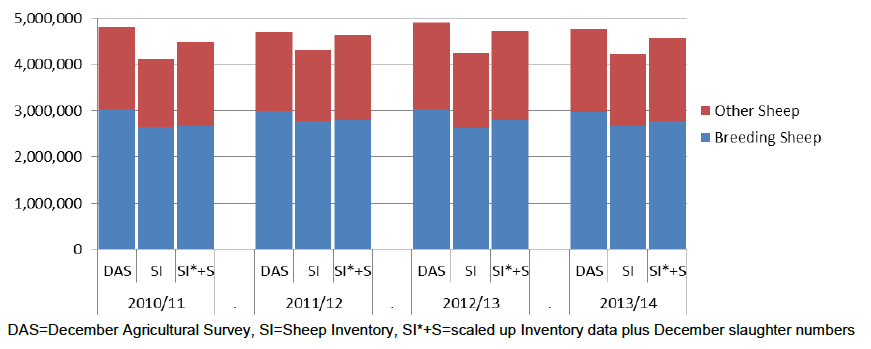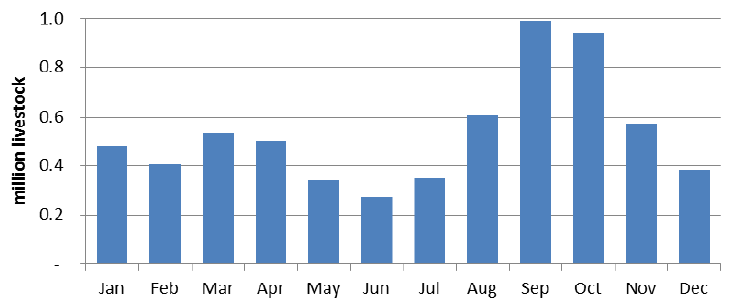Economic Report on Scottish Agriculture 2015
Economic Report on Scottish Agriculture 2015 presenting an overall picture of Scottish agriculture using data from the various agricultural surveys that RESAS manage.
This document is part of a collection
Annex A
Alternative Sources of Data on Sheep
RESAS has an on-going commitment to reduce the survey burden on our data providers, as well as to improve the data we use in modelling the industry. In June 2013, and in all subsequent collections, we have used cattle data obtained from the British Cattle Movement Service. This meant we could remove two large sections of data from our June and December forms. We have also used this source to obtain data relating to exports, imports, birth and deaths, used in Total Income from Farming calculations.
We are now investigating the use of administrative data relating particularly to sheep, and to a lesser extent pigs. These will come from two related sources and are defined by Sheep and Goats (Records, Identification and Movement) (Scotland) Order 2009 legislation.
Annual Sheep and Goats Inventory
Each January the government carries out an annual inventory of sheep and goat numbers. This is a survey sent to all registered sheep-keepers, which collects the number of sheep and goats, by holding, in the following categories
i. breeding sheep and lambs put to the ram
ii. other sheep (including lambs and rams)
iii. goats
The collection has historically been run by DEFRA, with the Animal Health and Welfare Division of the Scottish Government being responsible for keeping the keepers list up-to-date for Scotland. It collects information at the start of January, and so is most comparable to the December Agricultural Survey collection. There is a statutory requirement on livestock keepers to return the information. The inventory is a full census and as such has a much wider coverage than the December Agricultural Survey (which is approximately a 50 per cent sample of the larger holdings only), and also achieves higher response rates. It therefore seems a suitable candidate for providing the information collected in the December Survey.
Data have been obtained for the last four years’ inventories. These have been compared with the returns of the December Survey, the latter including estimates for holdings not included in the survey.
Estimated number of sheep in December

DAS=December Agricultural Survey, SI=Sheep Inventory, SI*+S=scaled up Inventory data plus December slaughter numbers
Initial comparison of the raw figures show a much lower figure for the inventory. However, two adjustments need to be made, firstly for non-response in the inventory, and secondly to account for the later survey date of the inventory. Scaling up the inventory numbers using the response rate and slaughter numbers for December gives data that are more comparable, though still lower than the December Survey, as shown in the chart.
There is however a requirement for greater detail of data at December than is currently collected in the Sheep Inventory. December sheep numbers are required by the European Union and also for the Total Income from Farming calculations, used as part of the National Accounts. The EU requires data in three categories
i. shearling ewes, gimmers and ewe lambs put to ram
ii. other ewes put to ram
iii. other sheep and lambs,
while the income calculations also require lambs, and gimmers and ewe lambs put to ram to be separately identified. This explains why the December Survey currently collects sheep data in nine categories.
It may therefore be possible to merge the two collections, with each keeper providing slightly more detail, but avoiding the duplication of those sampled in the December Survey providing sheep data twice, one month apart. Further analysis will be carried out during the summer to validate the comparability of the data. It is of advantage that there is a long time series of the inventory data available, which would allow us to backdate data in calculations such as those in Total Income from Farming (TIFF).
ScotEID Livestock movements system
ScotEID is a livestock traceability movement database that was initially set up to comply with the EU Regulation for sheep and goat identification and traceability. All movements of sheep within Scotland, including animals moving to or from England and Wales, are recorded, movements can be recorded electronically directly to the database or via the paper movement document which is manually entered onto the system The database has been expanded to include pig movements and record the individual/herd test results for the Scottish industry led Bovine Viral Diarrhoea eradication programme.
Movements are recorded in batches/lot level of animals rather than at the individual animal level. However, where sheep move via a market or abattoir their identity is read electronically and this is recorded individually on the database. Hence for all movements a record would include the holding the sheep have moved from, the holding to which they have moved, the date of movement, and the number of livestock moved, but for about 70 per cent of movements individual level data is also available.
Full data are available for 2014, though they have yet to be fully analysed. The raw data suggest a total number of 325,000 movements involving 6.4 million sheep. It should be noted that in terms of these figures, many of the movements and sheep numbers will be, in a sense, duplicated. Sheep moved from one location, via a market, to a new location will be recorded as two movements. Further analysis of the data will be able to remove this double counting.
Higher movement numbers were seen in September and October, due to large numbers of lambs from upland areas and hills being sold because they are not ready for slaughter and need lowland pasture for feeding and finishing through the autumn and winter. Many breeding lambs will also be moved down to low ground for their first winter.
Number of livestock moved in 2014, by month

In total there were about two million livestock moved out of Scotland, and 180,000 moved into Scotland, resulting in a net outflow of 1.8 million (of all ages). Currently we model for 2014 (from comparing consecutive census numbers in different categories) a total output of 2.8 million sheep (2.3 million lambs, 570,000 older sheep), and have recorded 1.4 million slaughtered in Scotland (1.35 million lambs, 29,000 older sheep). This means a modelled total net outflow from Scotland of 1.5 million sheep. More validation work will be required however to confirm this higher than modelled net outflow of sheep.
Unfortunately from a data point of view, the movements system does not identify the age of the livestock that move farm-to-farm, so we are unable to differentiate between movements of lambs and older animals. This will mean that, for use in TIFF calculations, assumptions will need to be made to obtain this split, though the totals will now be able to be scaled to correct amount. However, age data is available for movements through markets or abattoirs which cover about 70 per cent of movements.
Contact
Email: Agricultural Statistics
There is a problem
Thanks for your feedback